Applying Nursing Practice in Primary Healthcare Setting
VerifiedAdded on 2023/01/09
|8
|1862
|61
AI Summary
This document discusses the identified health literacy issues in older patients and provides strategies to support their capacity to understand. It also recommends health promotion programs and develops a care plan for Mrs. Reynolds in the primary healthcare setting. Considerations regarding different aspects, ensuring respectful practice, and the support of family are also discussed.
Contribute Materials
Your contribution can guide someone’s learning journey. Share your
documents today.
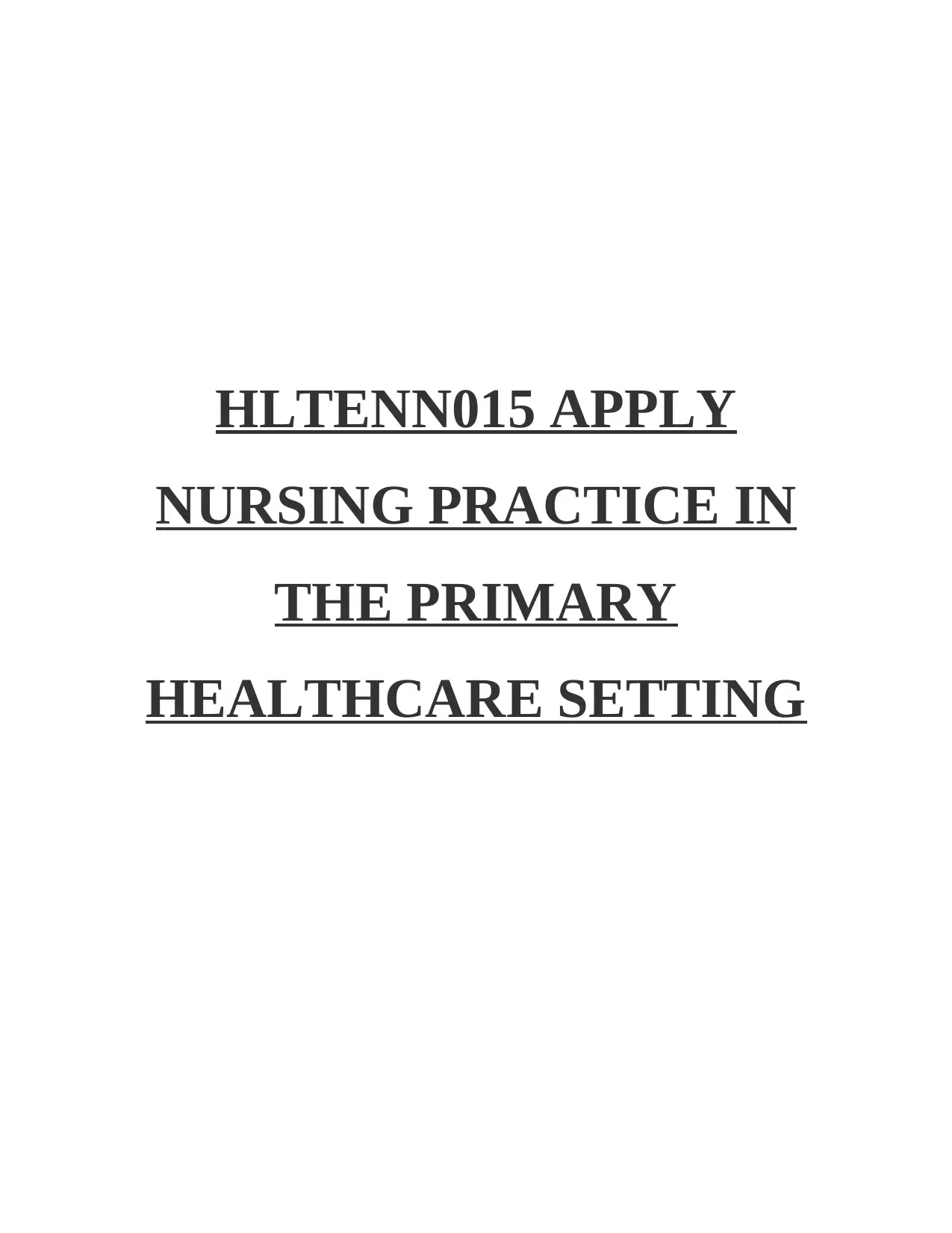
HLTENN015 APPLY
NURSING PRACTICE IN
THE PRIMARY
HEALTHCARE SETTING
NURSING PRACTICE IN
THE PRIMARY
HEALTHCARE SETTING
Secure Best Marks with AI Grader
Need help grading? Try our AI Grader for instant feedback on your assignments.
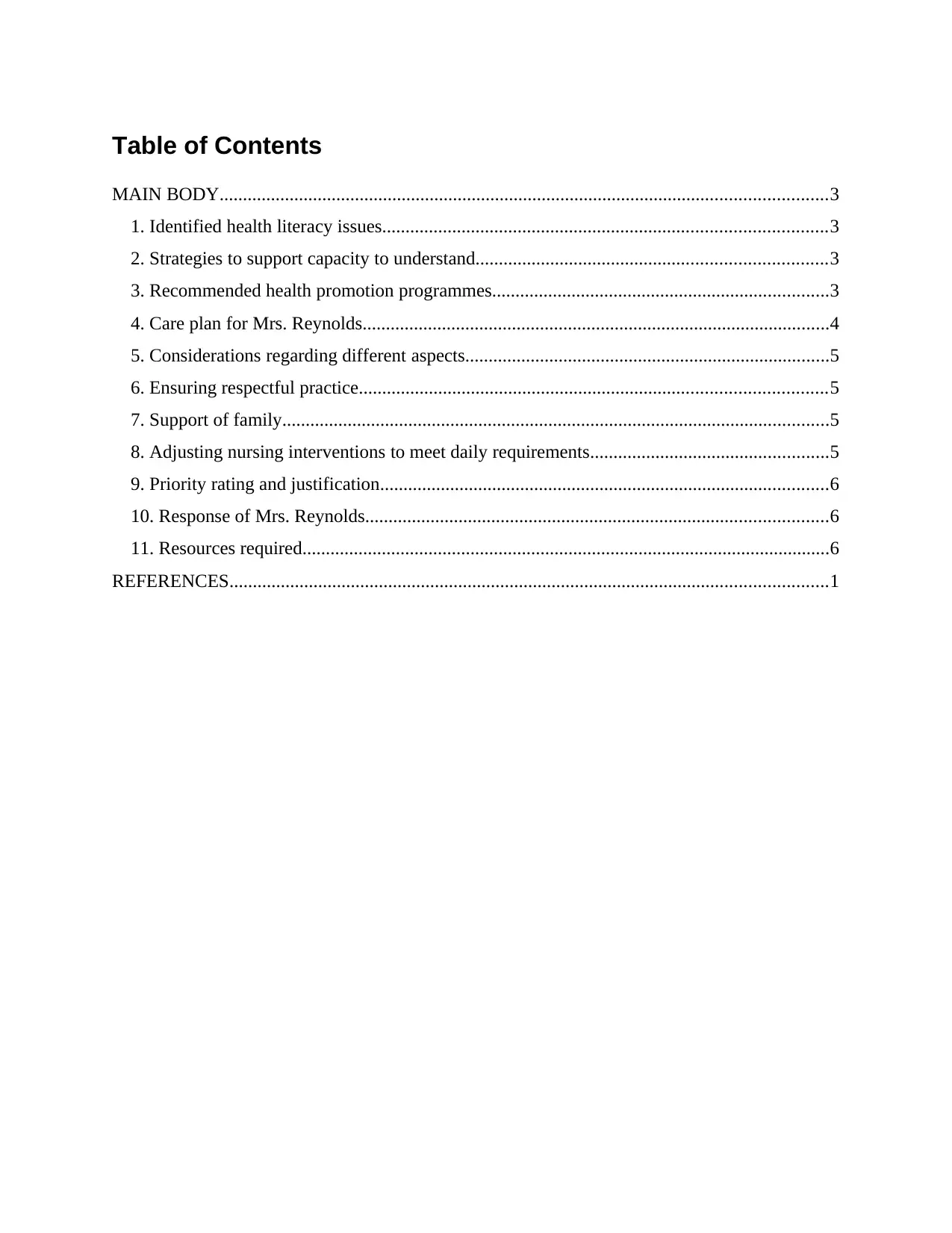
Table of Contents
MAIN BODY..................................................................................................................................3
1. Identified health literacy issues...............................................................................................3
2. Strategies to support capacity to understand...........................................................................3
3. Recommended health promotion programmes........................................................................3
4. Care plan for Mrs. Reynolds....................................................................................................4
5. Considerations regarding different aspects..............................................................................5
6. Ensuring respectful practice....................................................................................................5
7. Support of family.....................................................................................................................5
8. Adjusting nursing interventions to meet daily requirements...................................................5
9. Priority rating and justification................................................................................................6
10. Response of Mrs. Reynolds...................................................................................................6
11. Resources required.................................................................................................................6
REFERENCES................................................................................................................................1
MAIN BODY..................................................................................................................................3
1. Identified health literacy issues...............................................................................................3
2. Strategies to support capacity to understand...........................................................................3
3. Recommended health promotion programmes........................................................................3
4. Care plan for Mrs. Reynolds....................................................................................................4
5. Considerations regarding different aspects..............................................................................5
6. Ensuring respectful practice....................................................................................................5
7. Support of family.....................................................................................................................5
8. Adjusting nursing interventions to meet daily requirements...................................................5
9. Priority rating and justification................................................................................................6
10. Response of Mrs. Reynolds...................................................................................................6
11. Resources required.................................................................................................................6
REFERENCES................................................................................................................................1
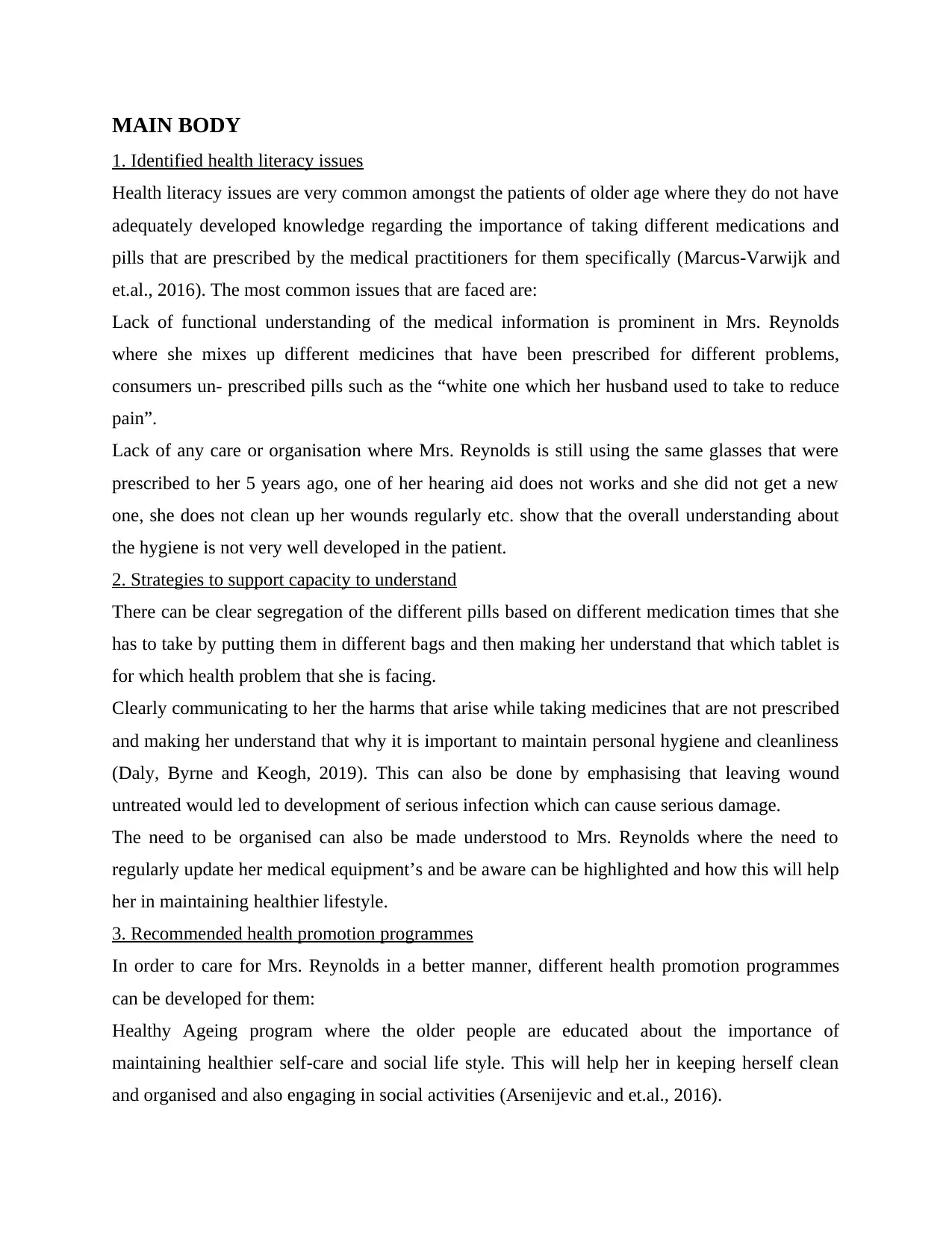
MAIN BODY
1. Identified health literacy issues
Health literacy issues are very common amongst the patients of older age where they do not have
adequately developed knowledge regarding the importance of taking different medications and
pills that are prescribed by the medical practitioners for them specifically (Marcus-Varwijk and
et.al., 2016). The most common issues that are faced are:
Lack of functional understanding of the medical information is prominent in Mrs. Reynolds
where she mixes up different medicines that have been prescribed for different problems,
consumers un- prescribed pills such as the “white one which her husband used to take to reduce
pain”.
Lack of any care or organisation where Mrs. Reynolds is still using the same glasses that were
prescribed to her 5 years ago, one of her hearing aid does not works and she did not get a new
one, she does not clean up her wounds regularly etc. show that the overall understanding about
the hygiene is not very well developed in the patient.
2. Strategies to support capacity to understand
There can be clear segregation of the different pills based on different medication times that she
has to take by putting them in different bags and then making her understand that which tablet is
for which health problem that she is facing.
Clearly communicating to her the harms that arise while taking medicines that are not prescribed
and making her understand that why it is important to maintain personal hygiene and cleanliness
(Daly, Byrne and Keogh, 2019). This can also be done by emphasising that leaving wound
untreated would led to development of serious infection which can cause serious damage.
The need to be organised can also be made understood to Mrs. Reynolds where the need to
regularly update her medical equipment’s and be aware can be highlighted and how this will help
her in maintaining healthier lifestyle.
3. Recommended health promotion programmes
In order to care for Mrs. Reynolds in a better manner, different health promotion programmes
can be developed for them:
Healthy Ageing program where the older people are educated about the importance of
maintaining healthier self-care and social life style. This will help her in keeping herself clean
and organised and also engaging in social activities (Arsenijevic and et.al., 2016).
1. Identified health literacy issues
Health literacy issues are very common amongst the patients of older age where they do not have
adequately developed knowledge regarding the importance of taking different medications and
pills that are prescribed by the medical practitioners for them specifically (Marcus-Varwijk and
et.al., 2016). The most common issues that are faced are:
Lack of functional understanding of the medical information is prominent in Mrs. Reynolds
where she mixes up different medicines that have been prescribed for different problems,
consumers un- prescribed pills such as the “white one which her husband used to take to reduce
pain”.
Lack of any care or organisation where Mrs. Reynolds is still using the same glasses that were
prescribed to her 5 years ago, one of her hearing aid does not works and she did not get a new
one, she does not clean up her wounds regularly etc. show that the overall understanding about
the hygiene is not very well developed in the patient.
2. Strategies to support capacity to understand
There can be clear segregation of the different pills based on different medication times that she
has to take by putting them in different bags and then making her understand that which tablet is
for which health problem that she is facing.
Clearly communicating to her the harms that arise while taking medicines that are not prescribed
and making her understand that why it is important to maintain personal hygiene and cleanliness
(Daly, Byrne and Keogh, 2019). This can also be done by emphasising that leaving wound
untreated would led to development of serious infection which can cause serious damage.
The need to be organised can also be made understood to Mrs. Reynolds where the need to
regularly update her medical equipment’s and be aware can be highlighted and how this will help
her in maintaining healthier lifestyle.
3. Recommended health promotion programmes
In order to care for Mrs. Reynolds in a better manner, different health promotion programmes
can be developed for them:
Healthy Ageing program where the older people are educated about the importance of
maintaining healthier self-care and social life style. This will help her in keeping herself clean
and organised and also engaging in social activities (Arsenijevic and et.al., 2016).
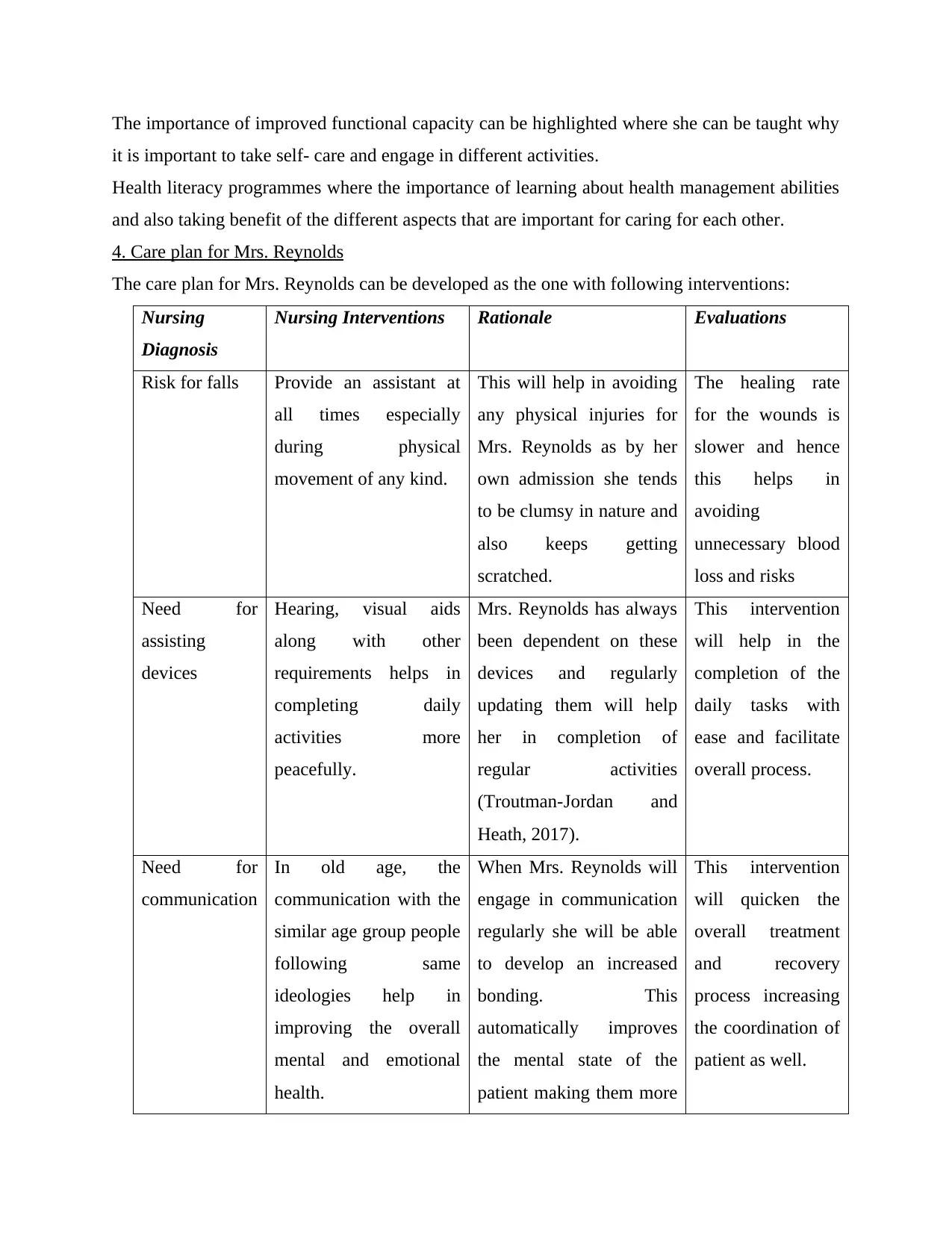
The importance of improved functional capacity can be highlighted where she can be taught why
it is important to take self- care and engage in different activities.
Health literacy programmes where the importance of learning about health management abilities
and also taking benefit of the different aspects that are important for caring for each other.
4. Care plan for Mrs. Reynolds
The care plan for Mrs. Reynolds can be developed as the one with following interventions:
Nursing
Diagnosis
Nursing Interventions Rationale Evaluations
Risk for falls Provide an assistant at
all times especially
during physical
movement of any kind.
This will help in avoiding
any physical injuries for
Mrs. Reynolds as by her
own admission she tends
to be clumsy in nature and
also keeps getting
scratched.
The healing rate
for the wounds is
slower and hence
this helps in
avoiding
unnecessary blood
loss and risks
Need for
assisting
devices
Hearing, visual aids
along with other
requirements helps in
completing daily
activities more
peacefully.
Mrs. Reynolds has always
been dependent on these
devices and regularly
updating them will help
her in completion of
regular activities
(Troutman-Jordan and
Heath, 2017).
This intervention
will help in the
completion of the
daily tasks with
ease and facilitate
overall process.
Need for
communication
In old age, the
communication with the
similar age group people
following same
ideologies help in
improving the overall
mental and emotional
health.
When Mrs. Reynolds will
engage in communication
regularly she will be able
to develop an increased
bonding. This
automatically improves
the mental state of the
patient making them more
This intervention
will quicken the
overall treatment
and recovery
process increasing
the coordination of
patient as well.
it is important to take self- care and engage in different activities.
Health literacy programmes where the importance of learning about health management abilities
and also taking benefit of the different aspects that are important for caring for each other.
4. Care plan for Mrs. Reynolds
The care plan for Mrs. Reynolds can be developed as the one with following interventions:
Nursing
Diagnosis
Nursing Interventions Rationale Evaluations
Risk for falls Provide an assistant at
all times especially
during physical
movement of any kind.
This will help in avoiding
any physical injuries for
Mrs. Reynolds as by her
own admission she tends
to be clumsy in nature and
also keeps getting
scratched.
The healing rate
for the wounds is
slower and hence
this helps in
avoiding
unnecessary blood
loss and risks
Need for
assisting
devices
Hearing, visual aids
along with other
requirements helps in
completing daily
activities more
peacefully.
Mrs. Reynolds has always
been dependent on these
devices and regularly
updating them will help
her in completion of
regular activities
(Troutman-Jordan and
Heath, 2017).
This intervention
will help in the
completion of the
daily tasks with
ease and facilitate
overall process.
Need for
communication
In old age, the
communication with the
similar age group people
following same
ideologies help in
improving the overall
mental and emotional
health.
When Mrs. Reynolds will
engage in communication
regularly she will be able
to develop an increased
bonding. This
automatically improves
the mental state of the
patient making them more
This intervention
will quicken the
overall treatment
and recovery
process increasing
the coordination of
patient as well.
Secure Best Marks with AI Grader
Need help grading? Try our AI Grader for instant feedback on your assignments.
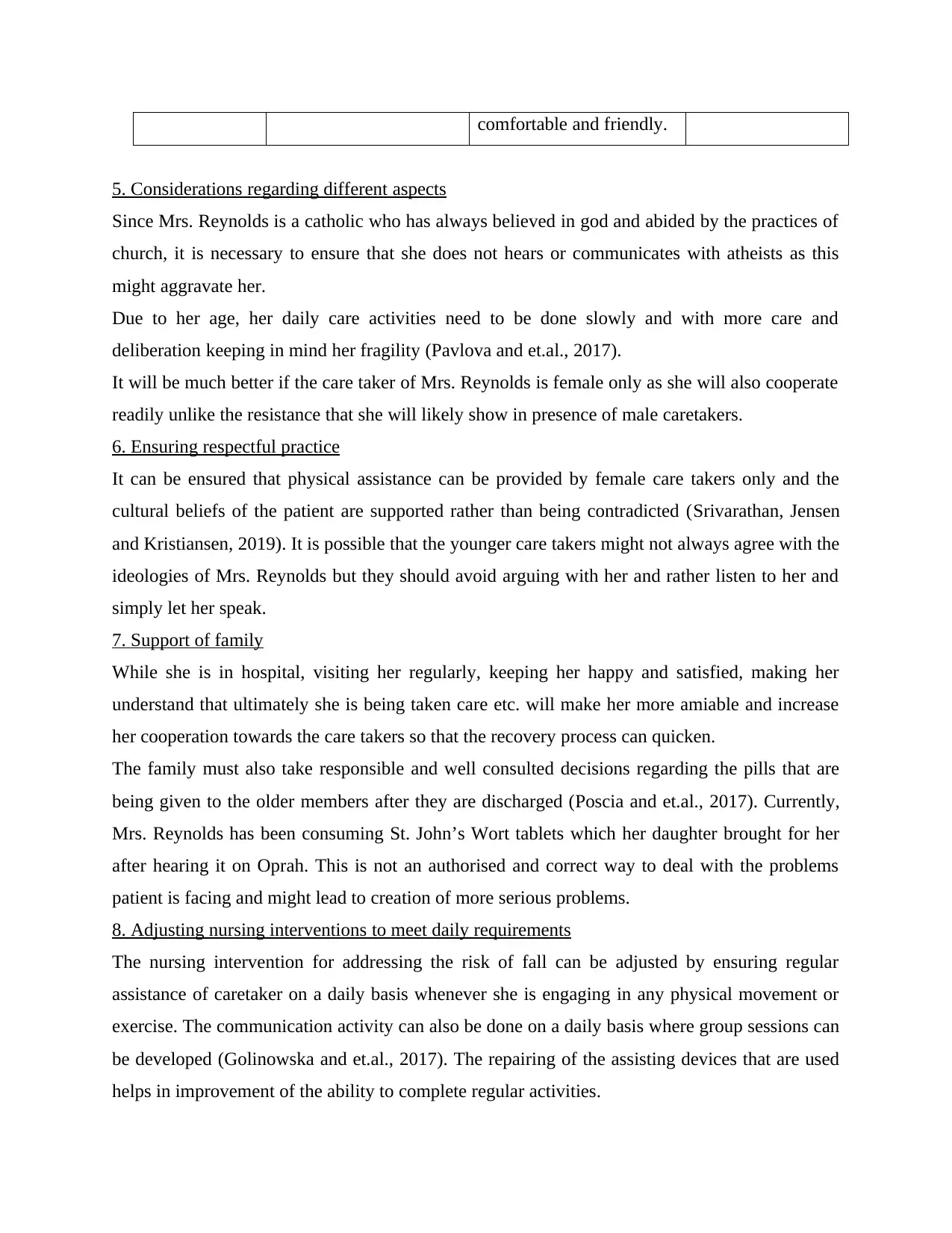
comfortable and friendly.
5. Considerations regarding different aspects
Since Mrs. Reynolds is a catholic who has always believed in god and abided by the practices of
church, it is necessary to ensure that she does not hears or communicates with atheists as this
might aggravate her.
Due to her age, her daily care activities need to be done slowly and with more care and
deliberation keeping in mind her fragility (Pavlova and et.al., 2017).
It will be much better if the care taker of Mrs. Reynolds is female only as she will also cooperate
readily unlike the resistance that she will likely show in presence of male caretakers.
6. Ensuring respectful practice
It can be ensured that physical assistance can be provided by female care takers only and the
cultural beliefs of the patient are supported rather than being contradicted (Srivarathan, Jensen
and Kristiansen, 2019). It is possible that the younger care takers might not always agree with the
ideologies of Mrs. Reynolds but they should avoid arguing with her and rather listen to her and
simply let her speak.
7. Support of family
While she is in hospital, visiting her regularly, keeping her happy and satisfied, making her
understand that ultimately she is being taken care etc. will make her more amiable and increase
her cooperation towards the care takers so that the recovery process can quicken.
The family must also take responsible and well consulted decisions regarding the pills that are
being given to the older members after they are discharged (Poscia and et.al., 2017). Currently,
Mrs. Reynolds has been consuming St. John’s Wort tablets which her daughter brought for her
after hearing it on Oprah. This is not an authorised and correct way to deal with the problems
patient is facing and might lead to creation of more serious problems.
8. Adjusting nursing interventions to meet daily requirements
The nursing intervention for addressing the risk of fall can be adjusted by ensuring regular
assistance of caretaker on a daily basis whenever she is engaging in any physical movement or
exercise. The communication activity can also be done on a daily basis where group sessions can
be developed (Golinowska and et.al., 2017). The repairing of the assisting devices that are used
helps in improvement of the ability to complete regular activities.
5. Considerations regarding different aspects
Since Mrs. Reynolds is a catholic who has always believed in god and abided by the practices of
church, it is necessary to ensure that she does not hears or communicates with atheists as this
might aggravate her.
Due to her age, her daily care activities need to be done slowly and with more care and
deliberation keeping in mind her fragility (Pavlova and et.al., 2017).
It will be much better if the care taker of Mrs. Reynolds is female only as she will also cooperate
readily unlike the resistance that she will likely show in presence of male caretakers.
6. Ensuring respectful practice
It can be ensured that physical assistance can be provided by female care takers only and the
cultural beliefs of the patient are supported rather than being contradicted (Srivarathan, Jensen
and Kristiansen, 2019). It is possible that the younger care takers might not always agree with the
ideologies of Mrs. Reynolds but they should avoid arguing with her and rather listen to her and
simply let her speak.
7. Support of family
While she is in hospital, visiting her regularly, keeping her happy and satisfied, making her
understand that ultimately she is being taken care etc. will make her more amiable and increase
her cooperation towards the care takers so that the recovery process can quicken.
The family must also take responsible and well consulted decisions regarding the pills that are
being given to the older members after they are discharged (Poscia and et.al., 2017). Currently,
Mrs. Reynolds has been consuming St. John’s Wort tablets which her daughter brought for her
after hearing it on Oprah. This is not an authorised and correct way to deal with the problems
patient is facing and might lead to creation of more serious problems.
8. Adjusting nursing interventions to meet daily requirements
The nursing intervention for addressing the risk of fall can be adjusted by ensuring regular
assistance of caretaker on a daily basis whenever she is engaging in any physical movement or
exercise. The communication activity can also be done on a daily basis where group sessions can
be developed (Golinowska and et.al., 2017). The repairing of the assisting devices that are used
helps in improvement of the ability to complete regular activities.
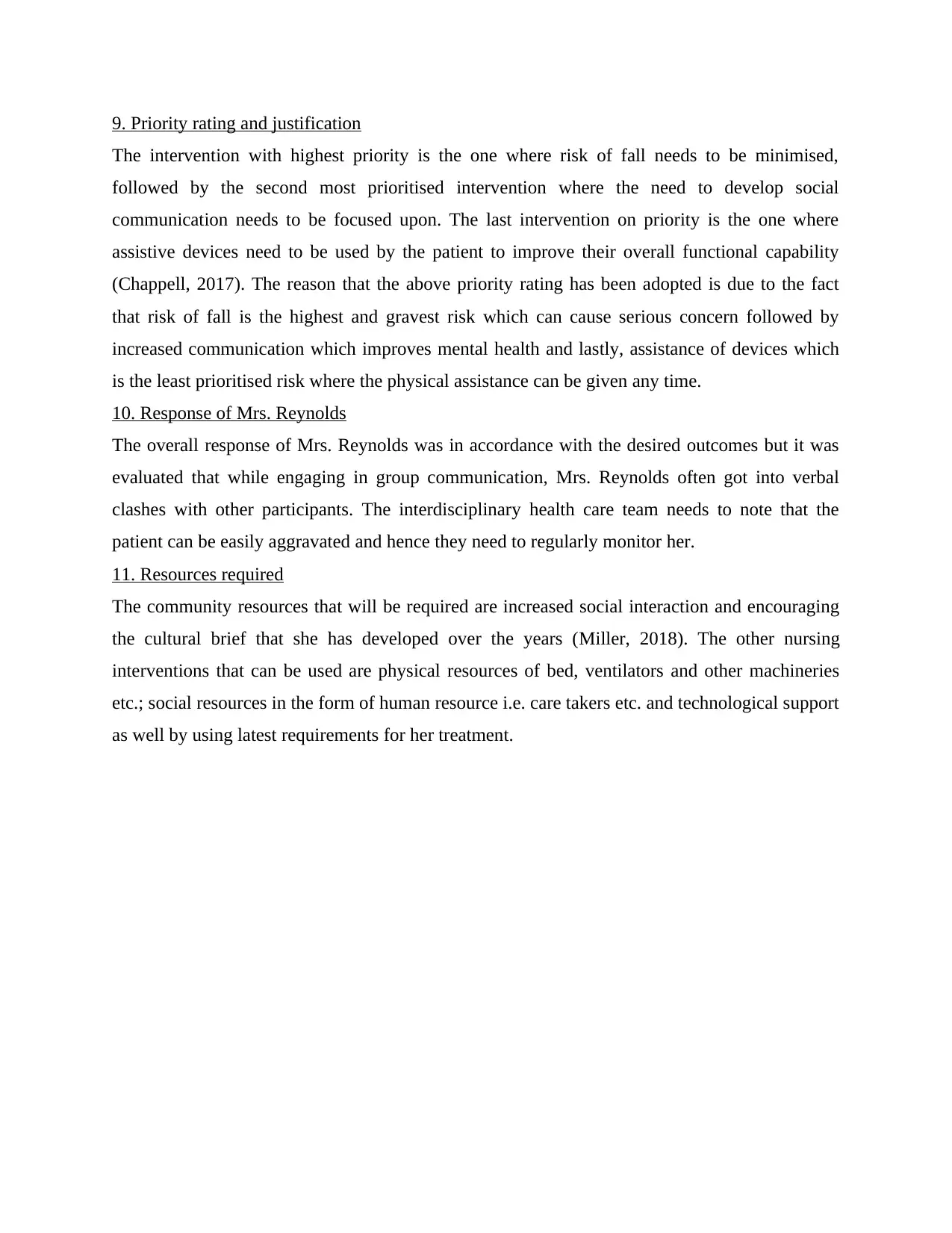
9. Priority rating and justification
The intervention with highest priority is the one where risk of fall needs to be minimised,
followed by the second most prioritised intervention where the need to develop social
communication needs to be focused upon. The last intervention on priority is the one where
assistive devices need to be used by the patient to improve their overall functional capability
(Chappell, 2017). The reason that the above priority rating has been adopted is due to the fact
that risk of fall is the highest and gravest risk which can cause serious concern followed by
increased communication which improves mental health and lastly, assistance of devices which
is the least prioritised risk where the physical assistance can be given any time.
10. Response of Mrs. Reynolds
The overall response of Mrs. Reynolds was in accordance with the desired outcomes but it was
evaluated that while engaging in group communication, Mrs. Reynolds often got into verbal
clashes with other participants. The interdisciplinary health care team needs to note that the
patient can be easily aggravated and hence they need to regularly monitor her.
11. Resources required
The community resources that will be required are increased social interaction and encouraging
the cultural brief that she has developed over the years (Miller, 2018). The other nursing
interventions that can be used are physical resources of bed, ventilators and other machineries
etc.; social resources in the form of human resource i.e. care takers etc. and technological support
as well by using latest requirements for her treatment.
The intervention with highest priority is the one where risk of fall needs to be minimised,
followed by the second most prioritised intervention where the need to develop social
communication needs to be focused upon. The last intervention on priority is the one where
assistive devices need to be used by the patient to improve their overall functional capability
(Chappell, 2017). The reason that the above priority rating has been adopted is due to the fact
that risk of fall is the highest and gravest risk which can cause serious concern followed by
increased communication which improves mental health and lastly, assistance of devices which
is the least prioritised risk where the physical assistance can be given any time.
10. Response of Mrs. Reynolds
The overall response of Mrs. Reynolds was in accordance with the desired outcomes but it was
evaluated that while engaging in group communication, Mrs. Reynolds often got into verbal
clashes with other participants. The interdisciplinary health care team needs to note that the
patient can be easily aggravated and hence they need to regularly monitor her.
11. Resources required
The community resources that will be required are increased social interaction and encouraging
the cultural brief that she has developed over the years (Miller, 2018). The other nursing
interventions that can be used are physical resources of bed, ventilators and other machineries
etc.; social resources in the form of human resource i.e. care takers etc. and technological support
as well by using latest requirements for her treatment.
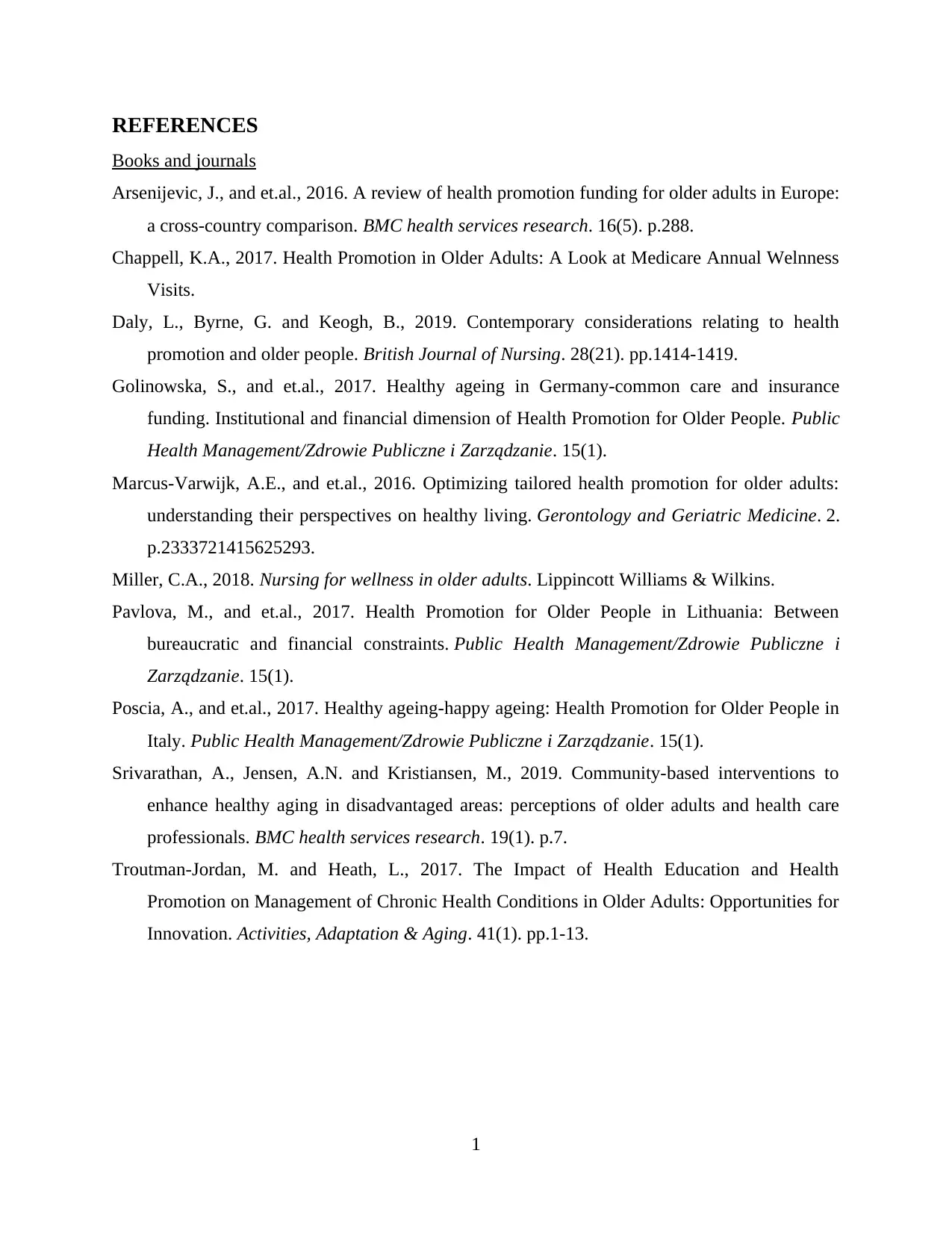
REFERENCES
Books and journals
Arsenijevic, J., and et.al., 2016. A review of health promotion funding for older adults in Europe:
a cross-country comparison. BMC health services research. 16(5). p.288.
Chappell, K.A., 2017. Health Promotion in Older Adults: A Look at Medicare Annual Welnness
Visits.
Daly, L., Byrne, G. and Keogh, B., 2019. Contemporary considerations relating to health
promotion and older people. British Journal of Nursing. 28(21). pp.1414-1419.
Golinowska, S., and et.al., 2017. Healthy ageing in Germany-common care and insurance
funding. Institutional and financial dimension of Health Promotion for Older People. Public
Health Management/Zdrowie Publiczne i Zarządzanie. 15(1).
Marcus-Varwijk, A.E., and et.al., 2016. Optimizing tailored health promotion for older adults:
understanding their perspectives on healthy living. Gerontology and Geriatric Medicine. 2.
p.2333721415625293.
Miller, C.A., 2018. Nursing for wellness in older adults. Lippincott Williams & Wilkins.
Pavlova, M., and et.al., 2017. Health Promotion for Older People in Lithuania: Between
bureaucratic and financial constraints. Public Health Management/Zdrowie Publiczne i
Zarządzanie. 15(1).
Poscia, A., and et.al., 2017. Healthy ageing-happy ageing: Health Promotion for Older People in
Italy. Public Health Management/Zdrowie Publiczne i Zarządzanie. 15(1).
Srivarathan, A., Jensen, A.N. and Kristiansen, M., 2019. Community-based interventions to
enhance healthy aging in disadvantaged areas: perceptions of older adults and health care
professionals. BMC health services research. 19(1). p.7.
Troutman-Jordan, M. and Heath, L., 2017. The Impact of Health Education and Health
Promotion on Management of Chronic Health Conditions in Older Adults: Opportunities for
Innovation. Activities, Adaptation & Aging. 41(1). pp.1-13.
1
Books and journals
Arsenijevic, J., and et.al., 2016. A review of health promotion funding for older adults in Europe:
a cross-country comparison. BMC health services research. 16(5). p.288.
Chappell, K.A., 2017. Health Promotion in Older Adults: A Look at Medicare Annual Welnness
Visits.
Daly, L., Byrne, G. and Keogh, B., 2019. Contemporary considerations relating to health
promotion and older people. British Journal of Nursing. 28(21). pp.1414-1419.
Golinowska, S., and et.al., 2017. Healthy ageing in Germany-common care and insurance
funding. Institutional and financial dimension of Health Promotion for Older People. Public
Health Management/Zdrowie Publiczne i Zarządzanie. 15(1).
Marcus-Varwijk, A.E., and et.al., 2016. Optimizing tailored health promotion for older adults:
understanding their perspectives on healthy living. Gerontology and Geriatric Medicine. 2.
p.2333721415625293.
Miller, C.A., 2018. Nursing for wellness in older adults. Lippincott Williams & Wilkins.
Pavlova, M., and et.al., 2017. Health Promotion for Older People in Lithuania: Between
bureaucratic and financial constraints. Public Health Management/Zdrowie Publiczne i
Zarządzanie. 15(1).
Poscia, A., and et.al., 2017. Healthy ageing-happy ageing: Health Promotion for Older People in
Italy. Public Health Management/Zdrowie Publiczne i Zarządzanie. 15(1).
Srivarathan, A., Jensen, A.N. and Kristiansen, M., 2019. Community-based interventions to
enhance healthy aging in disadvantaged areas: perceptions of older adults and health care
professionals. BMC health services research. 19(1). p.7.
Troutman-Jordan, M. and Heath, L., 2017. The Impact of Health Education and Health
Promotion on Management of Chronic Health Conditions in Older Adults: Opportunities for
Innovation. Activities, Adaptation & Aging. 41(1). pp.1-13.
1
Paraphrase This Document
Need a fresh take? Get an instant paraphrase of this document with our AI Paraphraser

2
1 out of 8
Related Documents
Your All-in-One AI-Powered Toolkit for Academic Success.
+13062052269
info@desklib.com
Available 24*7 on WhatsApp / Email
![[object Object]](/_next/static/media/star-bottom.7253800d.svg)
Unlock your academic potential
© 2024 | Zucol Services PVT LTD | All rights reserved.




